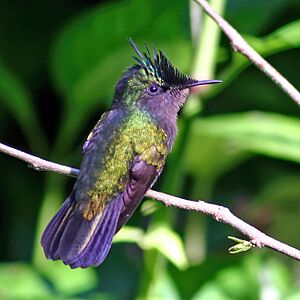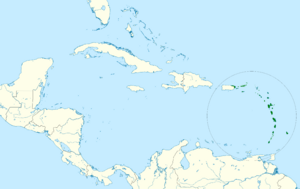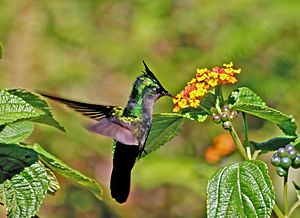Antillean crested hummingbird facts for kids
Quick facts for kids Antillean crested hummingbird |
|
|---|---|
 |
|
| Male in Morne Diablotins National Park, Dominica | |
| Conservation status | |
| Scientific classification | |
| Genus: |
Orthorhyncus
|
| Species: |
cristatus
|
 |
|
| Synonyms | |
|
Trochilus cristatus Linnaeus, 1758 |
|
The Antillean crested hummingbird (Orthorhyncus cristatus) is a tiny, colorful bird found on many islands in the Caribbean Sea. These islands include Anguilla, Barbados, Dominica, Grenada, Guadeloupe, Martinique, Montserrat, Puerto Rico, Saint Lucia, and the British Virgin Islands. Sometimes, it even flies as far as Florida in the USA!
Contents
What's in a Name?
The Antillean crested hummingbird gets its name from two things:
- Antillean: This refers to the Lesser Antilles, the group of islands where it mostly lives.
- Crested: This describes the cool, shiny crest of feathers on its head.
This hummingbird is special because it's the only species in its group, called the genus Orthorhyncus. A French scientist named Bernard Germain de Lacépède first described this group in 1799.
The name Orthorhyncus comes from ancient Greek words: orthos means "straight," and rhunkhos means "bill." This describes the bird's straight beak. The second part of its name, cristatus, is a Latin word meaning "crested" or "plumed," which points to its fancy head feathers.
Scientists recognize four different types, or subspecies, of this hummingbird:
- O. c. exilis
- O. c. ornatus
- O. c. cristatus
- O. c. emigrans
What Does It Look Like?
As its name suggests, the Antillean crested hummingbird is one of the few hummingbirds with a crest!
- Males are very bright and colorful. They have a short, straight black beak. Their head has a green crest that shines metallic green to bright blue-green. Their upper body is a dull metallic bronze-green, and their belly is sooty black. Their tail is black and rounded.
- Females are not as colorful. They have a similar beak but no crest. Their head and upper body are metallic bronzy-green, and their belly is light gray. Their tail is blackish with whitish-grey tips on the outer feathers.
You can tell the different subspecies apart by the color of their crests. For example, some have a wholly green crest, while others have blue or violet tips.
These birds make short "tsip" or "tzip" sounds. They also have a longer call that sounds like "tslee-tslee-tslee-tslee."
Where Do They Live?
Antillean crested hummingbirds live in many different places across the Caribbean islands. They like:
- Moist lowland forests
- Dry forests
- Open areas
- Parks
- Plantations
- Forest edges
They are most common in areas below 500 meters (about 1,640 feet) above sea level. They usually stay in one area and don't travel far.
How Do They Behave?
These hummingbirds are known for being quite protective of their space. They might chase away other hummingbirds, other birds, or even reptiles and insects! This behavior helps them protect their food sources and nesting areas.
Breeding
Antillean crested hummingbirds can breed all year round. However, they are most active from March to June.
- Their nest is shaped like a cup.
- They build it on thin branches of shrubs or vines, usually 1 to 3 meters (3 to 10 feet) above the ground.
- The nest is often hidden by leaves.
- The inside is soft, made of plant fibers.
- The outside is decorated with pieces of dead leaves, lichens, moss, or bark to help it blend in.
A female hummingbird usually lays two white eggs. She sits on the eggs for 17 to 19 days. She is very brave and will attack anything that comes too close to her nest! The chicks are dark gray with two rows of soft downy feathers on their backs. They stay in the nest for about 19 to 21 days. After they leave the nest, they stay with their mother for another 3 to 4 weeks. They usually start having their own babies when they are two years old.
Food and Feeding

The Antillean crested hummingbird's diet includes:
- Nectar: They drink nectar from many different flowering plants. These include shrubs like Lantana and Euphorbia, and large trees like the capparis tree, Hibiscus, and Bauhinia.
- Small bugs: They also eat small arthropods (like insects or spiders). They might pick these bugs off plant surfaces or catch them while flying.
They feed from plants close to the ground all the way up to the tops of tall trees. However, they seem to prefer the flowering plants that grow closer to the ground.
Are They Safe?
The Antillean crested hummingbird is not considered a threatened species. Scientists classify it as "Least Concern," which means there are plenty of them around. They are common residents throughout the Lesser Antilles. They can live in many different types of habitats, including areas changed by humans. This means that losing natural habitats is not a big problem for them.
See Also



